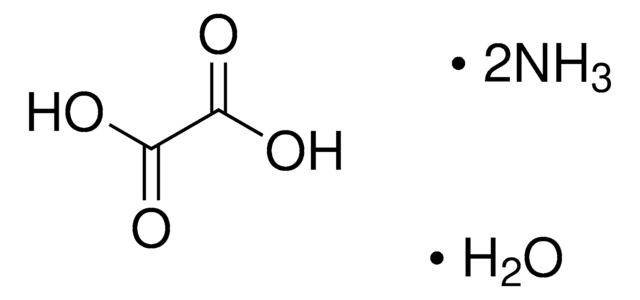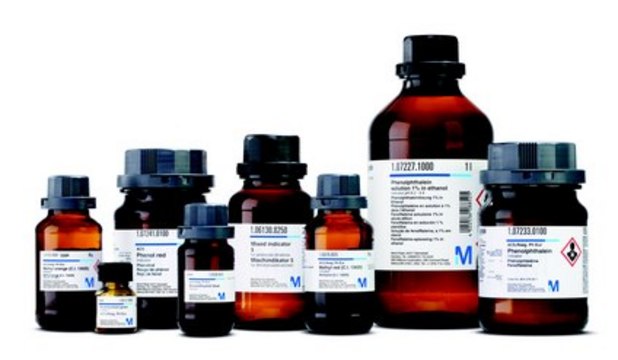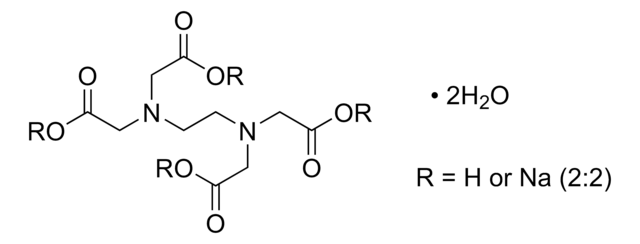371343
4-Hydroxy-TEMPO benzoate, free radical
97%
Synonym(s):
4-Hydroxy-TEMPO benzoate, 4-Hydroxy-2,2,6,6-tetramethylpiperidine 1-oxyl benzoate
Sign Into View Organizational & Contract Pricing
Select a Size
Change View
0.2 MG
CA$741.00
1 MG
CA$1,470.00
About This Item
Empirical Formula (Hill Notation):
C16H22NO3
CAS Number:
Molecular Weight:
276.35
Beilstein:
1431263
MDL number:
UNSPSC Code:
12352000
PubChem Substance ID:
NACRES:
NA.22
Recommended Products
Assay
97%
form
solid
mp
99-101 °C (lit.)
functional group
ester
phenyl
SMILES string
CC1(C)CC(CC(C)(C)N1[O])OC(=O)c2ccccc2
InChI
1S/C16H22NO3/c1-15(2)10-13(11-16(3,4)17(15)19)20-14(18)12-8-6-5-7-9-12/h5-9,13H,10-11H2,1-4H3
InChI key
MJEDTBDGYVATPI-UHFFFAOYSA-N
Looking for similar products? Visit Product Comparison Guide
General description
4-Hydroxy-TEMPO benzoate is a 4-substituted 2,2,6,6-tetramethylpiperidyl-1-oxy (TEMPO) derivative.
Application
4-Hydroxy-TEMPO benzoate was employed as spin probe to investigate the mechanism of synthesis of SBA-15 and to evaluate its surface properties and pore structure by electron paramagnetic resonance spectroscopy (EPR).[1] It was also used for the functionalization of various polydienes (polybutadiene and polyisoprene). Functionalized polydienes were analyzed by gel permeation chromatography.[2]
Recycling catalyst in hypochlorite/bromite-nitroxide oxidizing system for conversion of alcohols to aldehydes, ketones, and carboxylic acids. It circumvents the need to use a catalytic or stoichiometric heavy metal oxidant.[3]
Storage Class Code
11 - Combustible Solids
WGK
WGK 3
Flash Point(F)
Not applicable
Flash Point(C)
Not applicable
Personal Protective Equipment
dust mask type N95 (US), Eyeshields, Gloves
Choose from one of the most recent versions:
Already Own This Product?
Find documentation for the products that you have recently purchased in the Document Library.
Natalya V Belova et al.
The journal of physical chemistry. A, 112(14), 3209-3214 (2008-03-07)
The tautomeric properties of alpha-chlorinated acetylacetone, 3-chloro-2,4-pentanedione CH3C(O)-CHCl-C(O)CH3, have been investigated by gas electron diffraction (GED) and quantum chemical calculations (B3LYP and MP2 approximations with different basis sets up to cc-pVTZ). Analysis of the GED intensities resulted in the presence
Julien Massue et al.
Inorganic chemistry, 44(24), 8740-8748 (2005-11-22)
The reaction of tris(alkylthio)tetrathiafulvalene thiolates with 3-chloro-2,4-pentanedione affords tetrathiafulvalene (TTF) moieties substituted by the acetylacetone function (TTFSacacH), precursors of novel redox-active ligands: the acetylacetonate ions (TTFSacac). These TTFSacacHs have been characterized by X-ray diffraction analyses, and similar trends have been
Almeqdad Y Habashneh et al.
Archiv der Pharmazie, 347(6), 415-422 (2014-03-13)
A new series of N1-(flavon-6-yl)amidrazones were synthesized by reacting the hydrazonoyl chloride derived from 6-aminoflavone with the appropriate sec-cyclic amines. The antitumor activities of these compounds were evaluated on breast cancer (MCF-7) and leukemic (K562) cell lines. Among the compounds
Jennifer A Jacobsen et al.
Journal of medicinal chemistry, 54(2), 591-602 (2010-12-30)
Fragment-based lead design (FBLD) has been used to identify new metal-binding groups for metalloenzyme inhibitors. When screened at 1 mM, a chelator fragment library (CFL-1.1) of 96 compounds produced hit rates ranging from 29% to 43% for five matrix metalloproteases
Our team of scientists has experience in all areas of research including Life Science, Material Science, Chemical Synthesis, Chromatography, Analytical and many others.
Contact Technical Service



